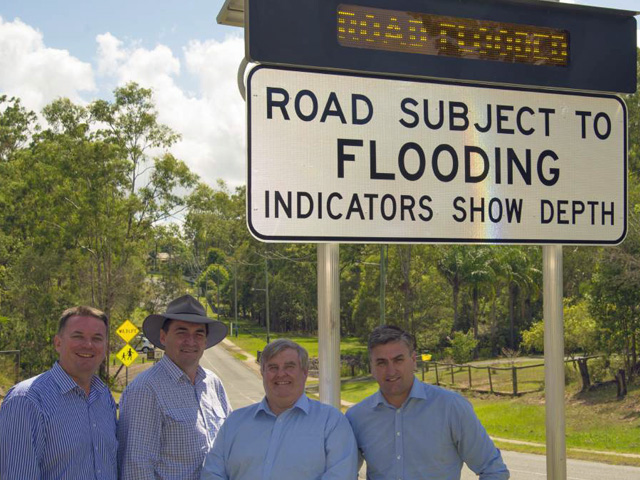FLOOD WARNING SMART SIGNS
27 Sep 2017
Recognising a need for clearer road warning signs during flood events, Logan City Council has installed several smart road warning systems throughout the municipality to ensure safe passage during extreme weather conditions.

After the 2015 Queensland floods, which saw a family car plunge into floodwaters, the Logan City Council recognised that signage during dangerous flooding conditions was not adequately preparing road users for the conditions ahead. In response to this need, the Logan City Council’s Flooded Road Smart Warning System (FRSWS) was developed.
“The crux of the problem was that it is almost impossible to see water over the road ahead at night, especially if there is no street lighting or the power is out,” explains Marty Wallace, Manager Road Construction & Maintenance at Logan City Council.
“There’s a public perception that most people who get into trouble have driven through floodwaters deliberately, but that’s not the reality. Most swift water rescues happen at night. The reality is, on a dark, wet night, headlights reflect off the water and there’s a high-risk that drivers won’t see the water at all.”
According to Mr Wallace, another challenge that councils typically face is the rapid change of water levels across multiple areas that require warning signs. While erecting temporary emergency signage can prevent such hazards, the unpredictability of natural weather systems means that it is not possible for council teams to be everywhere at once.
“Sometimes it’s not safe to send teams out to put up warning signs with lightning striking around them. During Cyclone Debbie last March, we had 110 roads with water over them,” says Mr Wallace.
The solution to these challenges was to create an automatic warning system that was capable of warning drivers of exact road conditions ahead as the situations develop, the FRSWS is the result of a collaboration between Logan City Council and Substation 33.
Substation 33, a local not-for-profit social enterprise, specialises in recycling e-waste and training and rehabilitation for disadvantaged peoples for entry/ re-entry into the workforce. The team at Substation 33 was able to incorporate a series of recycled components into the FRSWS signage.
“We engaged them to help produce a technical solution that could be upgraded and updated in the future, but also one that was cost-effective,” says Mr Wallace. “They helped develop and install our first model, which uses cables to connect the signs to a float switch only six months after the concept was first discussed.”
These Logan City Council’s Flooded Road Smart Warning System uses a road level trigger that prompts a change to the smart signage above existing flooding signage. Included in this system is a radio control unit and specifically designed printed circuit boards all of which is powered by solar-charged recycled batteries. The smart sign will flash ‘ROAD FLOODED’ to warn oncoming vehicles to seek alternative routes and alert the council's staff and responders, as well as updating the Disaster Dashboard website for the public.
“When the water goes over the road, it triggers the FRSWS and a radio unit sends a message to electronic signs 100 metres up the road on either side of the floodway,” says Mr Wallace.
The FRSWS implementation has helped improved driver safety surrounding flooded roadways, and the ongoing monitoring of the system during recent flooding is helping to inform the City of Logan about areas of improvement for the council risk management strategy around flooded roadways.
Research for the project identified 278 locations around Logan where roads are known to be flood-prone. “Using that information, we created our own risk criteria, which measured a flood site on five criteria – depth, velocity, visibility, depth, entry slope and sight distance,” says Mr. Wallace. This information has assisted the council to prioritise where it placed its FRSWS units and provided valuable information on its own road network at the same time.
Cyclone Debbie gave the system its first real test at the end of March 2017, when more than 100 roads across Logan were flooded. Unlike previous events, no vehicles drove into the floodwaters at the sites where the signs had been installed.
“It was very timely that we got this system in place because Cyclone Debbie resulted in one of the biggest floods in Logan’s history,” states City of Logan Councillor Phil Pidgeon. “Because it was such a big flood the system went completely underwater at two sites, but that’s part of the learning curve for us. No one can put a price on a human life.”







